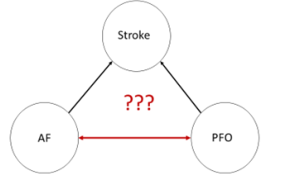
CRIB
cardiovascular research
institute basel
CONTACT
Leiter
Prof. Christian Müller
Spitalstrasse 2
CH-4056 Basel
Schweiz
© Prof. Christian Müller 2025

Study News
Alfa Romeo
(atrial fibrillation before and after patent foramen ovale closure
study)
Crypotgenic stroke - persistent foramen ovale - atrial fibrillation: What's the story behind?
In 20-40% of strokes, the underlying cause remains unclear despite extensive investigations. The two most
common causes are persistent foramen ovale and atrial fibrillation. The significance of persistent foramen
ovale as a direct cause of thrombus formation is still unclear. However, compared with the general population,
the prevalence of persistent formaen ovale (PFO) is significantly increased in patients with cryptogenic stroke.
For this reason, the PFO is usually closed with a minimally invasively procedure, using a PFO occluder.
Implantation of this occluder is associated with a low complication rate, including arrhythmias in 1.7% of cases.
Atrial fibrillation (AF) is recognized as a cause of cryptogenic stroke. Further strokes are therefore counteracted
by anticoagulation. Because AF is usually paroxysmal and asymptomatic, diagnosis can be challenging and
may not be detected by standard diagnostic methods (72h, 4day ECG). New implantable cardiac monitors (ICMs)
allow continuous cardiac rhythm monitoring for months to years.
The relationship between atrial fibrillation and PFO is complex and poorly understood. On the one hand, new-onset
AF episodes have been described after PFO closure, possibly as a result of irritation of the atrial wall by the
screen. On the other hand, the PFO itself could also be the underlying cause of AF.
The aim of the ALFA ROMEO study is to understand the aforementioned associations between cryptogenic stroke,
persistent patent foramen ovale (PFO), closure of the PFO, and AF. In this observational study, we record current
ICM protocols for AF detection in patients with cryptogenic stroke and PFO each 3 months before to 3 years after
PFO closure.
The ALFA ROMEO study is designed to help understand the association between silent and previously undetected
AF in the context of PFO and to capture the true incidence of new-onset AF before and after PFO closure.
The results could have an impact on the diagnostic and therapeutic management of patients with cryptogenic stroke.
The study, initiated by Prof Dr Raban Jeger (University Hospital Basel) and Prof Dr Tobias Reichlin (Inselspital Bern)
and conducted by the Interventional Cardiology Study Center at the CRIB, is supported by an SNF grant.
Six study centers with close collaboration of interventional cardiology, electrophysiology and neurology are
participating in the study: University Hospital Basel, University Hospital Inselspital Bern, University Hospital Zurich,
Canton Hospital St.Gallen, Bürgerspital Solothurn and Canton Hospital Aarau. All centers opened this year and the
first patients have already been enrolled. It is planned to enroll 200 patients over the next 2 years.



Prof. Christian Müller

Prof. Michael Kühne


Prof. Felix Mahfoud







